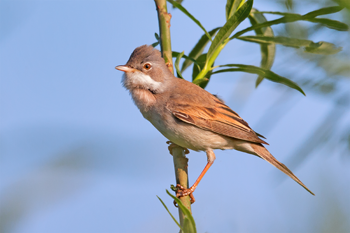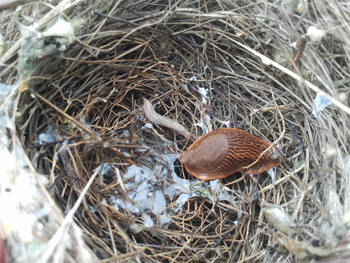Giant slugs snack on baby birds
Certain slimy slugs nosh on chicks as bird parents do nothing to stop them

A slug feasts on a baby bird’s butt in a yellowhammer nest on the ground.
Andrzej Wuczyński/Institute of Nature Conservation PAS
What harm could a slimy little critter slowly crawling on the forest floor possibly do to a bird? A lot, it turns out. Slugs are shell-less mollusks that have a specialized mouth with a sandpaper-like structure. That rough surface can easily rip the skin and eyes off of a baby bird, leaving the chick to fight for its life.
Many don’t survive.
To be sure, this chick-icide by slugs is rare, European scientists now report. Still, they note, it could become a problem for ground- and shrub-nesting birds if slug numbers climb.
Justyna Chachulska is a graduate student at the University of Zielona Góra in Poland. Katarzyna Turzańska studies at the University of Wrocław, also in Poland. In 2014, both PhD students were monitoring nests of the common whitethroat (Sylvia communis), a mid-size European warbler. The students were on the outskirts of the city of Wrocław.
The season was wet and cold. As a result, the ground teemed with slugs. One day, the young scientists noticed a slug in a nest with three newly-hatched chicks. They couldn’t imagine this slug posed a threat to the baby birds. So, they carried on with their work on other nests. But when they returned to the same nest the next day, two nestlings were dead. The third was missing.
Chachulska and Turzańska were determined to solve this avian murder mystery. And the slug they had seen became their prime suspect. Though the mollusk was long gone, it had left traces of evidence all over the crime scene. This included a colorless, glossy slime and its feces . What’s more, the dead nestlings were missing parts of their bodies.
Slugs don’t usually feed on bird chicks. The slimy invertebrates largely get by on plants, mushrooms and dead animals. But they do sometimes attack living, slow-moving creatures, such as worms. The defenseless nestlings must simply have been too tempting for the slugs to pass up. Chachulska and her colleague reported their finding in Ornis Polonica in 2015.

But since they had not witnessed the slug actually feeding on the chicks, they searched for more evidence. They scouted for reports by other scientists who had seen, photographed or even filmed such an event. And they found a few. The earliest published account dates back nearly a century — to 1922.
Most known chick-icides by slugs had taken place in the European countries of Poland, Germany and the Netherlands. (There was one sole U.S. report.) The affected young had been in nests on the ground or in shrubs — all sites to which slugs had ready access. Attacked species included relatively small birds, such as warblers, yellowhammers, blackcaps and chiffchaffs. The team published its new review of these events online August 13 in Journal of Avian Biology.
What they learned
From previous accounts, the researchers learned that slugs can tear or grind up any part of the young birds — skulls, bills, muscles, eyes or wings. But since a slug’s appetite is rather small, it does not always eat the entire chick.
Most attack reports indicted slugs belonging to the genus Arion. Three species in particular were cited most often — the red slug (Arion rufus), the black slug (Arion ater) and the invasive slug (Arion vulgaris).
Arion species are relatively large, at least the size of a human adult’s entire thumb. In contrast, songbird hatchlings, such as common whitethroat chicks, may be only as big as in-shell peanuts. They are blind and helpless in the face of an advancing slug. Even chicks about to fledge aren’t free from harm. They are bigger but still vulnerable to slugs. Eggs aren’t spared either. Chachulska found that slugs can punch a hole in an eggshell.

A parent bird never stepped in to somehow protect its brood, the study notes. This was true whether its eggs, newborns or fledglings fell under attack. Apart from a few harmless pecks, the parents didn’t do much to get rid of the slug.
Perhaps they tried and gave up. Arion slugs are full of muscle and moisture, so they are actually quite heavy, notes Ian Hartley. That means parent birds might not be able to lift and hurl such a predator from their nests.
Hartley is an ornithologist at Lancaster University in England who studies the family life of birds. He never has come across a slug feeding on a bird. He suspects that bird dinners might be rare and for slugs — even an accidental snack. And that, he adds, might explain why parent birds have not yet evolved a response against the new predator.
Although adult birds do not protect their chicks from the slimy attackers, Hartley says that the species that nest in the open have “a lot more to worry about than slugs.” Their main predators, he notes, are crows, squirrels, mice, rats and stoats.
“If we were seeing [chick deaths] a lot in lots of different species — maybe because the slug numbers were increasing — then it might be an issue,” he concludes.
Chachulska agrees: If the slug population mushrooms, there is a risk that these mollusks might become a real threat for breeding birds. For now it’s hard to gauge their threat because few people ever see slugs dining on a baby bird.







